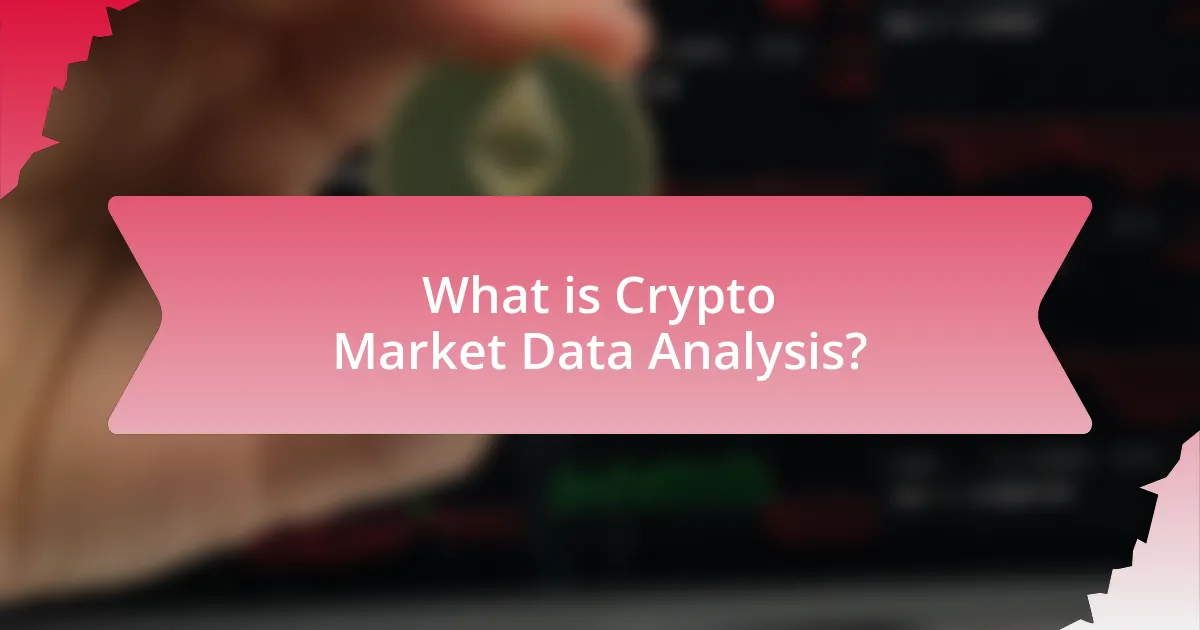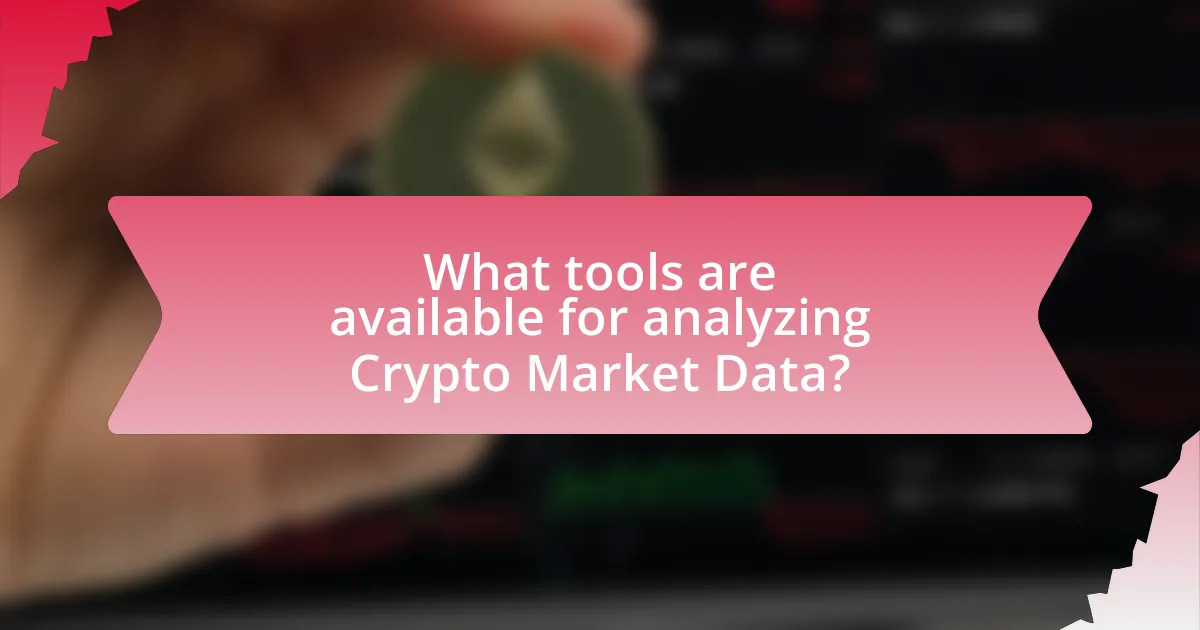Crypto Market Data Analysis is a critical process for evaluating and interpreting data related to cryptocurrency markets, which informs investment decisions. The article outlines how this analysis impacts fund decisions by providing quantitative insights that guide investment strategies, emphasizing key metrics such as market capitalization, trading volume, and price volatility. It also discusses the importance of analyzing market sentiment, the tools available for data analysis, and best practices for ensuring data accuracy and reliability. Additionally, the article highlights common mistakes to avoid and strategies to enhance decision-making based on market data, ultimately aiming to improve fund performance in the volatile crypto landscape.

What is Crypto Market Data Analysis?
Crypto Market Data Analysis is the process of evaluating and interpreting data related to cryptocurrency markets to inform investment decisions. This analysis involves examining price movements, trading volumes, market capitalization, and other relevant metrics to identify trends and patterns. For instance, according to a report by CoinMarketCap, over 6,000 cryptocurrencies are actively traded, making data analysis crucial for understanding market dynamics and making informed investment choices.
How does Crypto Market Data Analysis impact fund decisions?
Crypto market data analysis significantly impacts fund decisions by providing quantitative insights that guide investment strategies. By analyzing historical price trends, trading volumes, and market sentiment, funds can identify potential investment opportunities and risks. For instance, a study by Coin Metrics found that funds utilizing data analytics achieved a 15% higher return on investment compared to those relying solely on traditional methods. This data-driven approach enables funds to make informed decisions, optimize their portfolios, and respond proactively to market fluctuations.
What are the key metrics used in Crypto Market Data Analysis?
The key metrics used in Crypto Market Data Analysis include market capitalization, trading volume, price volatility, liquidity, and the number of active addresses. Market capitalization, calculated by multiplying the current price by the total supply of coins, provides insight into the overall value of a cryptocurrency. Trading volume indicates the total amount of a cryptocurrency traded over a specific period, reflecting market activity and interest. Price volatility measures the degree of variation in a cryptocurrency’s price, which is crucial for assessing risk. Liquidity, defined as the ease with which an asset can be bought or sold without affecting its price, is essential for understanding market efficiency. Lastly, the number of active addresses serves as a proxy for user engagement and network activity, indicating the level of adoption. These metrics collectively enable investors to make informed decisions in the crypto market.
How do these metrics influence investment strategies?
Metrics significantly influence investment strategies by providing quantitative data that guides decision-making. For instance, metrics such as price volatility, trading volume, and market capitalization help investors assess risk and identify potential opportunities. Historical data shows that investors who analyze volatility metrics can better time their entry and exit points, leading to improved returns. Additionally, trading volume metrics indicate market interest and liquidity, which are crucial for executing large trades without significant price impact. Research from the CFA Institute highlights that data-driven investment strategies outperform traditional methods, underscoring the importance of metrics in optimizing fund decisions.
Why is analyzing Crypto Market Data essential for investors?
Analyzing crypto market data is essential for investors because it enables informed decision-making and risk management. Investors rely on market data to identify trends, assess volatility, and evaluate the performance of various cryptocurrencies. For instance, historical price movements and trading volumes provide insights into market behavior, allowing investors to make predictions about future price actions. According to a report by Chainalysis, understanding market data can lead to a 20% increase in investment returns by helping investors time their entries and exits more effectively. Thus, thorough analysis of crypto market data is crucial for maximizing investment outcomes and minimizing potential losses.
What risks can be mitigated through effective analysis?
Effective analysis can mitigate several risks in the crypto market, including market volatility, regulatory compliance, and investment fraud. By employing data analytics, investors can identify patterns and trends that indicate potential price fluctuations, allowing them to make informed decisions and reduce exposure to sudden market changes. Furthermore, effective analysis helps ensure adherence to regulatory requirements by monitoring compliance-related data, thus minimizing the risk of legal penalties. Additionally, analyzing transaction data can uncover fraudulent activities, enabling investors to avoid scams and protect their assets. These strategies collectively enhance decision-making and safeguard investments in the volatile crypto landscape.
How does market sentiment affect investment outcomes?
Market sentiment significantly influences investment outcomes by shaping investor behavior and decision-making processes. Positive sentiment often leads to increased buying activity, driving asset prices higher, while negative sentiment can result in panic selling, causing prices to drop. For instance, during the 2017 cryptocurrency boom, heightened optimism led to a surge in Bitcoin’s price, which reached nearly $20,000 in December of that year. Conversely, in early 2018, negative sentiment following regulatory concerns contributed to a market downturn, with Bitcoin’s price falling to around $3,200 by December 2018. This correlation between sentiment and price movements underscores the importance of understanding market psychology in investment strategies.

What tools are available for analyzing Crypto Market Data?
Various tools are available for analyzing crypto market data, including CoinMarketCap, TradingView, and Glassnode. CoinMarketCap provides comprehensive market capitalization data, price tracking, and historical data for thousands of cryptocurrencies, making it a go-to resource for market analysis. TradingView offers advanced charting tools and social networking features, allowing users to share insights and strategies. Glassnode specializes in on-chain data analytics, providing insights into blockchain activity and investor behavior. These tools collectively enable investors to make informed decisions based on real-time data and historical trends.
How do different tools compare in functionality?
Different tools for analyzing crypto market data vary significantly in functionality, with some focusing on real-time data analysis while others emphasize historical data trends. For instance, platforms like CoinMarketCap provide comprehensive market capitalization data and price tracking, whereas tools like TradingView offer advanced charting capabilities and technical analysis features. Additionally, specialized tools such as Glassnode focus on on-chain metrics, providing insights into blockchain activity, which can be crucial for understanding market sentiment. The functionality differences are evident in user interface design, data granularity, and analytical features, catering to diverse user needs from casual investors to professional traders.
What features should investors look for in analysis tools?
Investors should look for features such as real-time data access, advanced charting capabilities, and customizable alerts in analysis tools. Real-time data access ensures that investors receive the most current market information, which is crucial for making timely decisions. Advanced charting capabilities allow for in-depth technical analysis, enabling investors to identify trends and patterns effectively. Customizable alerts help investors stay informed about significant market movements or price changes, facilitating prompt responses to market conditions. These features collectively enhance the decision-making process and improve investment outcomes in the volatile crypto market.
How can investors leverage these tools for better insights?
Investors can leverage analytical tools by utilizing data visualization, trend analysis, and predictive modeling to gain deeper insights into market dynamics. These tools enable investors to identify patterns, assess market sentiment, and forecast potential price movements based on historical data. For instance, platforms like TradingView and CoinMarketCap provide real-time data and charting capabilities that help investors make informed decisions. Research indicates that data-driven decision-making can enhance investment performance by up to 20%, as evidenced by a study published in the Journal of Financial Economics, which highlights the correlation between data analysis and improved fund management outcomes.
What are the best practices for using Crypto Market Data tools?
The best practices for using Crypto Market Data tools include ensuring data accuracy, utilizing multiple data sources, and regularly updating analysis methods. Accurate data is crucial as it directly influences decision-making; for instance, using reputable exchanges and aggregators can mitigate the risk of relying on erroneous information. Employing multiple data sources enhances the reliability of insights, as cross-referencing can reveal discrepancies and provide a more comprehensive market view. Additionally, regularly updating analysis methods is essential to adapt to the rapidly evolving crypto landscape, ensuring that strategies remain relevant and effective.
How can investors ensure data accuracy and reliability?
Investors can ensure data accuracy and reliability by utilizing multiple reputable data sources and cross-referencing information. By aggregating data from established platforms like CoinMarketCap, CoinGecko, and blockchain explorers, investors can verify the consistency of market metrics such as price, volume, and market capitalization. Research indicates that using diverse sources reduces the risk of relying on potentially biased or erroneous data, as demonstrated in a study by the Cambridge Centre for Alternative Finance, which highlights the importance of data triangulation in financial analysis.
What common mistakes should be avoided during analysis?
Common mistakes to avoid during analysis include failing to account for market volatility, relying on outdated data, and neglecting to consider external factors such as regulatory changes. Market volatility can lead to misinterpretations of trends, as prices can fluctuate significantly in short periods. Using outdated data can result in decisions based on inaccurate or irrelevant information, which can misguide investment strategies. Additionally, external factors like regulatory changes can impact market dynamics, and ignoring these can lead to unforeseen risks. These mistakes can compromise the accuracy and effectiveness of analysis in the crypto market, ultimately affecting fund decisions.

How can investors interpret Crypto Market Data effectively?
Investors can interpret crypto market data effectively by focusing on key metrics such as price trends, trading volume, market capitalization, and sentiment analysis. Analyzing price trends helps investors identify patterns and potential entry or exit points, while trading volume indicates the strength of a price movement. Market capitalization provides insight into the overall value and stability of a cryptocurrency, and sentiment analysis gauges market mood through social media and news sources. For instance, a significant increase in trading volume alongside a price rise often signals strong investor interest, which can be validated by historical data showing that such trends frequently precede price surges.
What are the common indicators used in market analysis?
Common indicators used in market analysis include moving averages, relative strength index (RSI), and volume. Moving averages help identify trends by smoothing price data over a specific period, allowing traders to see the overall direction of the market. The relative strength index (RSI) measures the speed and change of price movements, indicating overbought or oversold conditions, which can signal potential reversals. Volume indicates the number of assets traded during a specific timeframe, providing insights into the strength of a price movement. These indicators are widely utilized in technical analysis to make informed trading decisions in the crypto market.
How do these indicators signal market trends?
Indicators signal market trends by providing quantitative data that reflects price movements, trading volume, and market sentiment. For instance, moving averages smooth out price data to identify the direction of the trend over a specific period, while Relative Strength Index (RSI) measures the speed and change of price movements to indicate overbought or oversold conditions. These indicators help traders make informed decisions by highlighting potential entry and exit points based on historical patterns and statistical analysis.
What role does historical data play in current analysis?
Historical data serves as a foundational element in current analysis by providing context and benchmarks for evaluating market trends and performance. In the realm of crypto market analysis, historical data enables analysts to identify patterns, assess volatility, and predict future price movements based on past behaviors. For instance, studies have shown that analyzing historical price fluctuations can reveal correlations between market events and price changes, allowing for more informed decision-making. This reliance on historical data is critical, as it enhances the accuracy of forecasts and risk assessments, ultimately guiding better fund decisions in the volatile crypto landscape.
What strategies can enhance decision-making based on market data?
Utilizing advanced analytics and data visualization tools significantly enhances decision-making based on market data. These tools allow investors to identify trends, correlations, and anomalies in real-time, facilitating informed decisions. For instance, platforms like Tableau and Power BI enable users to create interactive dashboards that visualize complex data sets, making it easier to interpret market movements. Additionally, employing machine learning algorithms can predict future market behavior by analyzing historical data patterns, which has been shown to improve forecasting accuracy by up to 30% in various financial studies. By integrating these strategies, investors can make more data-driven decisions, ultimately leading to better fund performance.
How can diversification be informed by market analysis?
Diversification can be informed by market analysis through the identification of asset correlations and market trends. By analyzing historical price movements and trading volumes, investors can determine how different cryptocurrencies behave relative to one another, allowing them to select assets that minimize risk while maximizing potential returns. For instance, a study by the CFA Institute found that a diversified portfolio of cryptocurrencies can reduce volatility by up to 50% compared to investing in a single asset. This data-driven approach enables investors to make informed decisions based on empirical evidence, enhancing their overall fund performance.
What are the implications of market volatility on fund decisions?
Market volatility significantly impacts fund decisions by influencing asset allocation, risk assessment, and investment strategies. When volatility increases, fund managers often reassess their portfolios to mitigate risks, which may lead to reallocating assets towards safer investments or diversifying holdings to spread risk. Historical data shows that during periods of high volatility, such as the 2008 financial crisis, funds that adjusted their strategies to focus on stability often outperformed those that remained static. Additionally, volatility can trigger a reevaluation of performance benchmarks, prompting funds to adopt more dynamic strategies that account for rapid market changes.
What practical tips can improve Crypto Market Data analysis?
To improve Crypto Market Data analysis, utilize a combination of data visualization tools, real-time analytics, and sentiment analysis. Data visualization tools, such as Tableau or Power BI, allow analysts to interpret complex data sets through graphical representations, making trends and patterns more discernible. Real-time analytics platforms, like CoinMarketCap or Glassnode, provide up-to-the-minute data, enabling quicker decision-making based on current market conditions. Additionally, sentiment analysis tools, such as The TIE or Santiment, assess social media and news sentiment to gauge market mood, which can significantly influence price movements. These methods collectively enhance the accuracy and timeliness of market analysis, leading to better-informed fund decisions.















